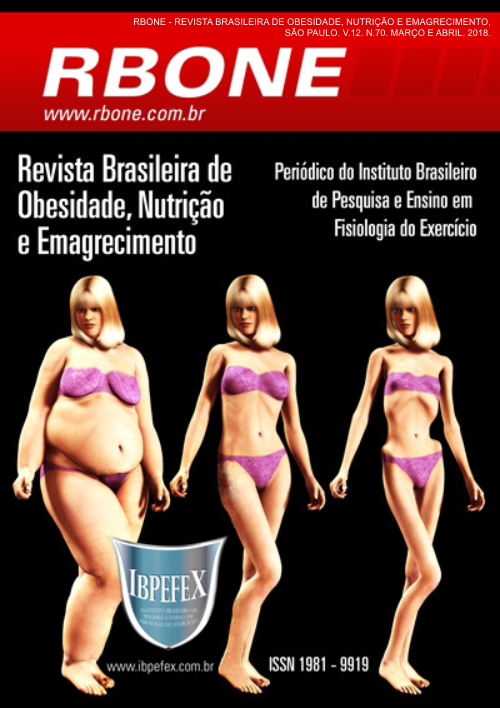Nutritional status and sensory perception in older adults with visual impairment
Abstract
Introduction: More than thirty million people worldwide have vision loss, and in Brazil, vision impairment affects more than 18% of the population. Nutritional characterization of the visually impaired is fundamental the, as it assists in the development of appropriate methods of intervention and education in Nutrition nonexistent so far. Objective: evaluate the nutritional profile and sensorial perception of adults and elderly visually impaired. Method: Transversal study which analyzed socioeconomic and demographic data, health habits, nutritional profile and food consumption, beyond the sensorial capabilities of 27 users of a non-profitable institute at Caxias do Sul-RS. Results: the socioeconomic and demographic data analyses showed the predominance of female individuals, unmarried, with partial dependence of third party, from B and C economic classes, unemployed and without medical insurances. Most of the users are no smokers and sedentary. Although most of the users have good eating there was a prevalence of overweight among them. The sensorial analysis showed that the visual experience during life had influence over the fruit recognition. Conclusion: The evaluated users require monitoring from a nutritionist to improve their nutritional condition, since overweight and abdominal fat concentration at the abdominal are aware verified, which could be related to the absence of physical activity of this individual.
References
-ABEP Critério de Classificação Socioeconômica Brasil (Brazilian Economic Classification Criteria) [Internet]. Associação Brasileira de Empresas e Pesquisa (ABEP), 2008. Disponível em:<http://www.abep.org/criterio-brasil>.
-Abreu, T.; Friedman, R.; Fayh, A. P. T. Aspectos fisiopatológicos e avaliação do estado nutricional de indivíduos com deficiências físicas. Revista do Hospital de Clínicas de Vol. 31. Num. 3. 2011. p. 345-352.
-Alves, M. L. T.; Duarte, E. Imagem corporal e deficiência visual: um estudo bibliográfico das relações entre a cegueira e o desenvolvimento da imagem corporal. Acta Scientarium -Human and Social Science. Vol. 30. Num. 2. 2008. p. 147-154.
-Barreto, F.; Panziera, C.; Sant'Anna, M. M.; Mascarenhas, M. Á.; Fayh, A. P. T. Avaliação nutricional de pessoas com deficiência praticantes de natação. Revista Brasileira de Medicina do Esporte. Vol. 15. Num. 3. 2009. p. 214-218.
-Domingues, A. R. Atendimento à família do deficiente: transformando o sentido da deficiência. In: Rocha EF. Reabilitação de pessoas com deficiência: a intervenção em discussão. Roca. 2006.
-Filho, V. T. F. B.; Ventura, R. U.; Brandt, C. T.; Sarteschi, C.; Ventura, M. C. Impacto de déficit visual na qualidade de vida em idosos usuários do Sistema Único de Saúde vivendo no sertão de Pernambuco. Arquivos Brasileiros de Oftalmologia. Vol. 75. Num 3. 2012. p. 161-165.
-Fonseca, M. J. M.; Chor, D.; Valente, J. G. Hábitos alimentares entre funcionários de banco estatal: padrão de consumo alimentar. Cadernos de Saúde Pública. Vol. 15. Num. 1. 1999. p. 29-39.
-Guimarães, F. J.; Santos, S. Avaliação antropométrica e de composição corporal de atletas paraolímpicos brasileiros. Revista Brasileira de Medicina do Esporte. Vol. 8. 2002. p. 84-91.
-IBGE. Instituto Brasileiro de Geografia e Estatística Censo 2010. Disponível em: <http://censo2010.ibge.gov.br>.
-Interdonato, G. C.; Greguol, M. Auto-Análise da imagem corporal de adolescentes com deficiência visual sedentarismos e fisicamente ativos. Revista da Faculdade de Educação Física da UNICAMP. Vol. 7. Num. 3. 2009. p. 1-13.
-Melo,H. F. R. Deficiência visual: lições práticas de orientação e mobilidade. Campinas. Unicamp. 1991.
-Montilha, R.; Temporini, E. R.; Nobre, M. I. R. S.; Gasparetto, M. E. R. F.; José, N. K. Deficiência visual: características e expectativas da clientela de serviço de reabilitação. Revista Ciências Médicas. Vol. 9. Num. 3. 2000. p. 123-128.
-Morales, P. H.; Lavinsky, D.; Vianello, S.; e colaboradores. Parecer da Sociedade Brasileira de Retina e Vítreo -Retinopatia Diabética, 2010. In: Diretrizes da Sociedade Brasileira de Diabetes: 2013-2014. Sociedade Brasileira de Diabetes. Organização José Egidio Paulo de Oliveira, Sérgio Vencio. AC Farmacêutica. 2014.
-Nobrega,A. C. L. Posicionamento oficial da Sociedade Brasileira de Medicina do Esporte e da Sociedade Brasileira de Geriatria e Gerontologia: atividade física e saúde no idoso. Revista Brasileira de Medicina do Esporte. Vol. 5. Num. 6. 1999. p. 207-211.
-Oliveira, S. I.; Oliveira, K. S. Novas perspectivas em educação alimentar e nutricional. Psicologia USP. Vol. 19. Num. 4. 2008. p. 495-504.
-SBD (Sociedade Brasileira de Diabetes). Diretrizes da Sociedade Brasileira de Diabetes: 2013-2014. Sociedade Brasileira de Diabetes. Organização José Egidio Paulo de Oliveira, Sérgio Vencio.AC Farmacêutica.2014.
-Torres, H. C.; Candido, N. A.; Alexandre, L. R.; Pereira, FL. O processo de elaboração de cartilhas para orientação do autocuidado no programa educativo em Diabetes. Revista Brasileira de Enfermagem. Vol. 62. Num. 2. 2009. p. 312-316.
-Valter, C. A.; Panziera, C.; Ribeiro, J. L.; Sant'Anna, M. M.; Faya, A. P. T. Perfil antropométrico e consumo alimentar de indivíduos com deficiência praticantes de natação e futsal. Revista Digital. Vol. 150. 2010. Disponível em:<http://www.efdeportes.com/efd150/consumo-alimentar-de-individuos-com-deficiencia.htm>.
-WHO. Relatório mundial sobre a deficiência (World report on disability) [Internet]. World Health Organization (WHO), 2011.Disponível em: .
Authors who publish in this journal agree to the following terms:
- Authors retain the copyright and grant the journal the right of first publication, with work simultaneously licensed under the Creative Commons Attribution License BY-NC which allows the sharing of the work with acknowledgment of the authorship of the work and initial publication in this journal.
- Authors are authorized to enter into additional contracts separately for non-exclusive distribution of the version of the work published in this journal (eg, publishing in institutional repository or book chapter), with acknowledgment of authorship and initial publication in this journal.
- Authors are allowed and encouraged to post and distribute their work online (eg, in institutional repositories or on their personal page) at any point before or during the editorial process, as this can bring about productive change as well as increase impact and impact. citation of published work (See The Effect of Free Access).






